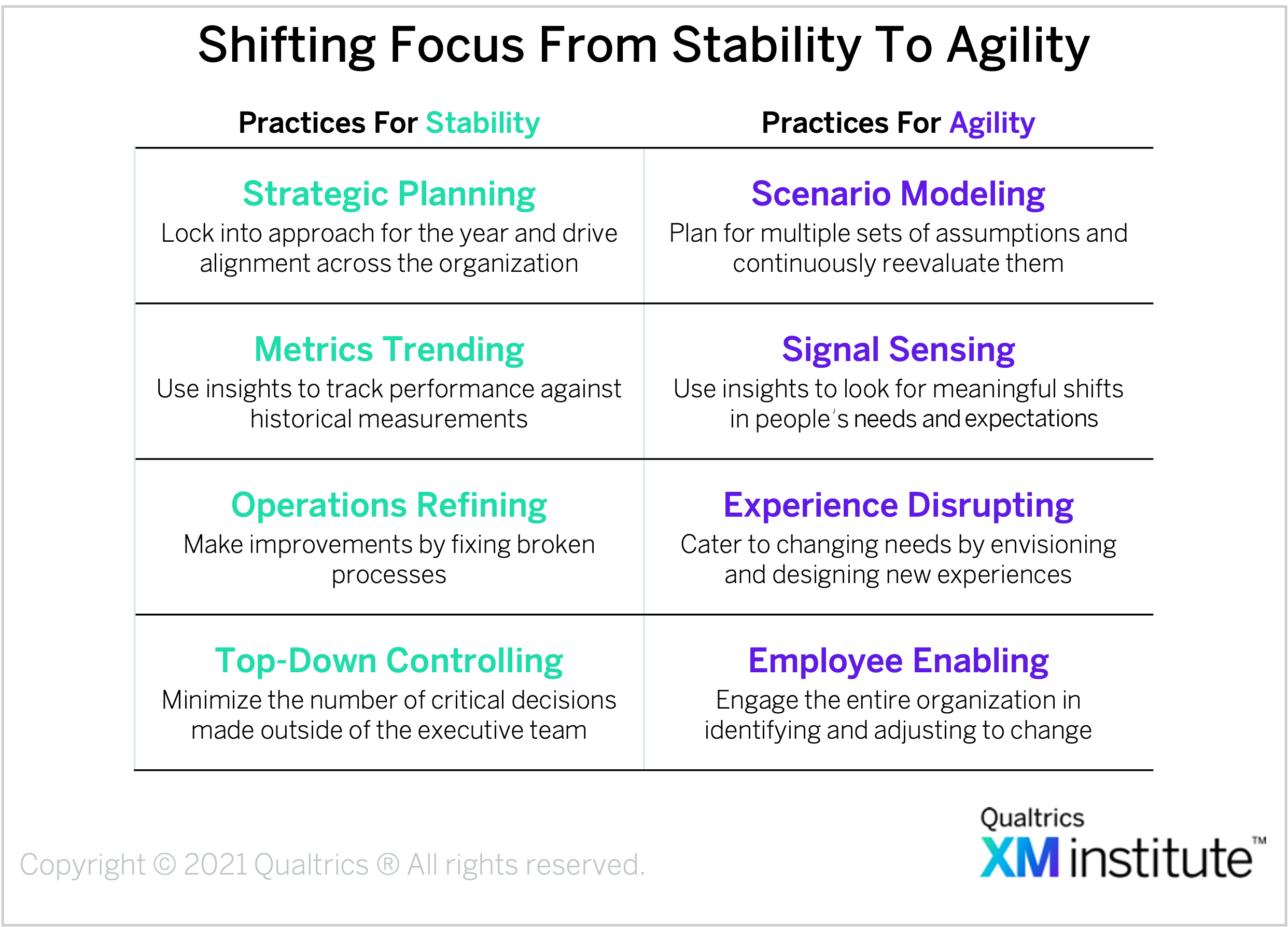As we enter into 2022, organizations need to prepare for ongoing shifts in the needs and expectations of customers and employees. That’s why XM Institute is labeling 2022, “The Year of Agility.” Join us as we explore the topic of agility throughout the year, in our content, and within the XM Professionals Network.
The only thing certain about next year is that it will be unpredictable. The combination of COVID, tangled supply chains, emerging inflation, employee off/onboarding, and customer demand shifts will force just about every organization to make many adjustments throughout the year. In this environment, companies must revamp traditional stability-oriented operating models with capabilities to more quickly sense and respond to what people are thinking and feeling. This level of agility will heavily rely on the capabilities of Experience Management (XM).
Four Practices For Building Agility
When you look at how organizations operate, most of what they do is optimized around minimizing risks from operational deviations. This emphasis on internal controls and efficiency stems back several decades to the start of the production era when data was hard to access and people were merely inputs to production systems. While technology has enabled entirely new practices and we’ve developed a much deeper understanding of what drives human behaviors and business success, these new realities have not yet been widely translated into how companies operate.
Given the ongoing changes in customer and employee demands that companies will face over the next couple of years, it’s time for leaders to dramatically rethink how they operate. They need to adopt more flexible, human-centric approaches. Instead of clinging to stability-ensuring activities, 2022 will be a good time to embrace more agility-oriented practices. Here are some changes to consider:
- Scenario modeling. Rather than assuming that you will know enough at the beginning of the year to lock into a cohesive strategy, consider possible scenarios and identify your best course of action for each one. For instance, an exercise company like Peleton may need to prepare for different potential environments, such as 1) large numbers of people shifting back to in-person exercise classes, or 2) a surge in COVID creating another spike in demand for at-home equipment. Even if 2022 doesn’t specifically match any of your scenarios, the process of planning for different scenarios will prepare you to respond to many variations.
- Signal sensing. As I’ve previously written, times of change require a significant shift from a focus on trending to an obsession with sensing. Instead of tracking existing metrics and doing longitudinal analysis, XM programs need to intensely examine what’s happening right now. The time and energy spent reconciling changes in core measurements like NPS and employee engagement is better spent looking for emerging signals in what customers, employees, and partners are thinking and feeling. This will require ongoing adjustments in the experience insights you collect and analyze, along with continuous cross-functional discussions about the implications and next steps.
- Experience disrupting. Most organizations are set up to drive incremental improvements, using XM to identify and fix broken processes. While this is valuable in times of stability when people’s needs are relatively fixed, it may fall very short in delivering sustainable value as people’s needs are shifting. That’s why organizations need to look for ways to actively disrupt the status quo by using experience design to create new, differentiated experiences that address people’s evolving needs.
- Employee enabling. While employees have always been the catalyst for any organization’s success, they will be even more important in 2022. The combination of increasing employee attrition and the need for driving change will force leaders to be much more employee-centric in how they operate. Rather than relying on employees to follow top-down decisions made by senior leaders, organizations will need to engage their entire workforce in spotting and adjusting to change, as employees will be a key gating factor in an organization’s ability to make adjustments.

XM Is The Foundation For Agility
Since all of the agility-building practices require a better understanding of customers and employees, most organizations will need to upgrade their XM efforts in 2022. The importance of XM in this changing environment becomes crystal clear when we examine how XM Institute describes the three underlying XM capabilities:
- Continuously learn. XM enables organizations to discover and interpret signals about how all of the people throughout their ecosystem are thinking and feeling in an ongoing fashion.
- Propagate insights. XM enables organizations to share relevant, actionable insights with people across an organization.
- Rapidly adapt. As the flow of actionable insights increases, XM efforts empower organizations to quickly and meaningfully act on that information.
XM Professionals: Capture This Moment!
While the environment in 2022 should be extremely conducive for XM, many organizations will continue to neglect their XM efforts. That’s why XM professionals can’t take this moment for granted. You need to help your organizations understand why XM is so important right now and how it can help drive success in a shifting environment. Here are some initial steps that you can take:
- Share the concept of 2022 as the Year of Agility across your organization, and lead discussions about how (poorly) prepared different groups are for this environment.
- Hold a brainstorming session with your XM team to identify ways that your XM efforts can be shifted to better support agility across your organization.
- Work with different teams across your organization to identify how XM can help them build more agility into their efforts, emphasizing the need to keep a pulse on how customers and employees are thinking and feeling.
- Stop talking about XM in terms of metrics, and start talking about the enabling capabilities of XM in a way that will resonate with senior executives.
- Keep an eye on the XM Institute site as we will be publishing more content on agility, and join the XM Professionals Network to engage in discussions about XM and agility with your peers and the XM Institute faculty.
The bottom line: Tap into XM to build agility in 2022.
Bruce Temkin, XMP, CCXP, is the Head of Qualtrics XM Institute





